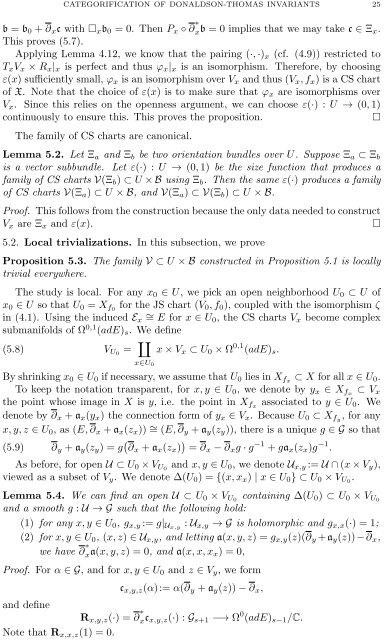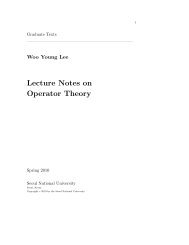Categorification of Donaldson-Thomas invariants via perverse ...
Categorification of Donaldson-Thomas invariants via perverse ...
Categorification of Donaldson-Thomas invariants via perverse ...
Create successful ePaper yourself
Turn your PDF publications into a flip-book with our unique Google optimized e-Paper software.
CATEGORIFICATION OF DONALDSON-THOMAS INVARIANTS 25b = b 0 + ∂ x c with □ x b 0 = 0. Then P x ◦ ∂ ∗ xb = 0 implies that we may take c ∈ Ξ x .This proves (5.7).Applying Lemma 4.12, we know that the pairing (·, ·) x (cf. (4.9)) restricted toT x V x × R x | x is perfect and thus ϕ x | x is an isomorphism. Therefore, by choosingε(x) sufficiently small, ϕ x is an isomorphism over V x and thus (V x , f x ) is a CS chart<strong>of</strong> X. Note that the choice <strong>of</strong> ε(x) is to make sure that ϕ x are isomorphisms overV x . Since this relies on the openness argument, we can choose ε(·) : U → (0, 1)continuously to ensure this. This proves the proposition.□The family <strong>of</strong> CS charts are canonical.Lemma 5.2. Let Ξ a and Ξ b be two orientation bundles over U. Suppose Ξ a ⊂ Ξ bis a vector subbundle. Let ε(·) : U → (0, 1) be the size function that produces afamily <strong>of</strong> CS charts V(Ξ b ) ⊂ U × B using Ξ b . Then the same ε(·) produces a family<strong>of</strong> CS charts V(Ξ a ) ⊂ U × B, and V(Ξ a ) ⊂ V(Ξ b ) ⊂ U × B.Pro<strong>of</strong>. This follows from the construction because the only data needed to constructV x are Ξ x and ε(x).□5.2. Local tri<strong>via</strong>lizations. In this subsection, we proveProposition 5.3. The family V ⊂ U × B constructed in Proposition 5.1 is locallytri<strong>via</strong>l everywhere.The study is local. For any x 0 ∈ U, we pick an open neighborhood U 0 ⊂ U <strong>of</strong>x 0 ∈ U so that U 0 = X f0 for the JS chart (V 0 , f 0 ), coupled with the isomorphism ζin (4.1). Using the induced E x∼ = E for x ∈ U0 , the CS charts V x become complexsubmanifolds <strong>of</strong> Ω 0,1 (adE) s . We define(5.8) V U0 = ∐x × V x ⊂ U 0 × Ω 0,1 (adE) s .x∈U 0By shrinking x 0 ∈ U 0 if necessary, we assume that U 0 lies in X fx ⊂ X for all x ∈ U 0 .To keep the notation transparent, for x, y ∈ U 0 , we denote by y x ∈ X fx ⊂ V xthe point whose image in X is y, i.e. the point in X fx associated to y ∈ U 0 . Wedenote by ∂ x + a x (y x ) the connection form <strong>of</strong> y x ∈ V x . Because U 0 ⊂ X fy , for anyx, y, z ∈ U 0 , as (E, ∂ x + a x (z x )) ∼ = (E, ∂ y + a y (z y )), there is a unique g ∈ G so that(5.9) ∂ y + a y (z y ) = g ( ∂ x + a x (z x ) ) = ∂ x − ∂ x g · g −1 + ga x (z x )g −1 .As before, for open U ⊂ U 0 × V U0 and x, y ∈ U 0 , we denote U x,y := U ∩ (x × V y ),viewed as a subset <strong>of</strong> V y . We denote ∆(U 0 ) = {(x, x x ) | x ∈ U 0 } ⊂ U 0 × V U0 .Lemma 5.4. We can find an open U ⊂ U 0 × V U0 containing ∆(U 0 ) ⊂ U 0 × V U0and a smooth g : U → G such that the following hold:(1) for any x, y ∈ U 0 , g x,y := g| Ux,y : U x,y → G is holomorphic and g x,x (·) = 1;(2) for x, y ∈ U 0 , (x, z) ∈ U x,y , and letting a(x, y, z) = g x,y (z)(∂ y +a y (z))−∂ x ,we have ∂ ∗ xa(x, y, z) = 0, and a(x, x, x x ) = 0,Pro<strong>of</strong>. For α ∈ G, and for x, y ∈ U 0 and z ∈ V y , we formc x,y,z (α):= α(∂ y + a y (z)) − ∂ x ,and defineR x,y,z (·) = ∂ ∗ xc x,y,z (·) : G s+1 −→ Ω 0 (adE) s−1 /C.Note that R x,x,z (1) = 0.













